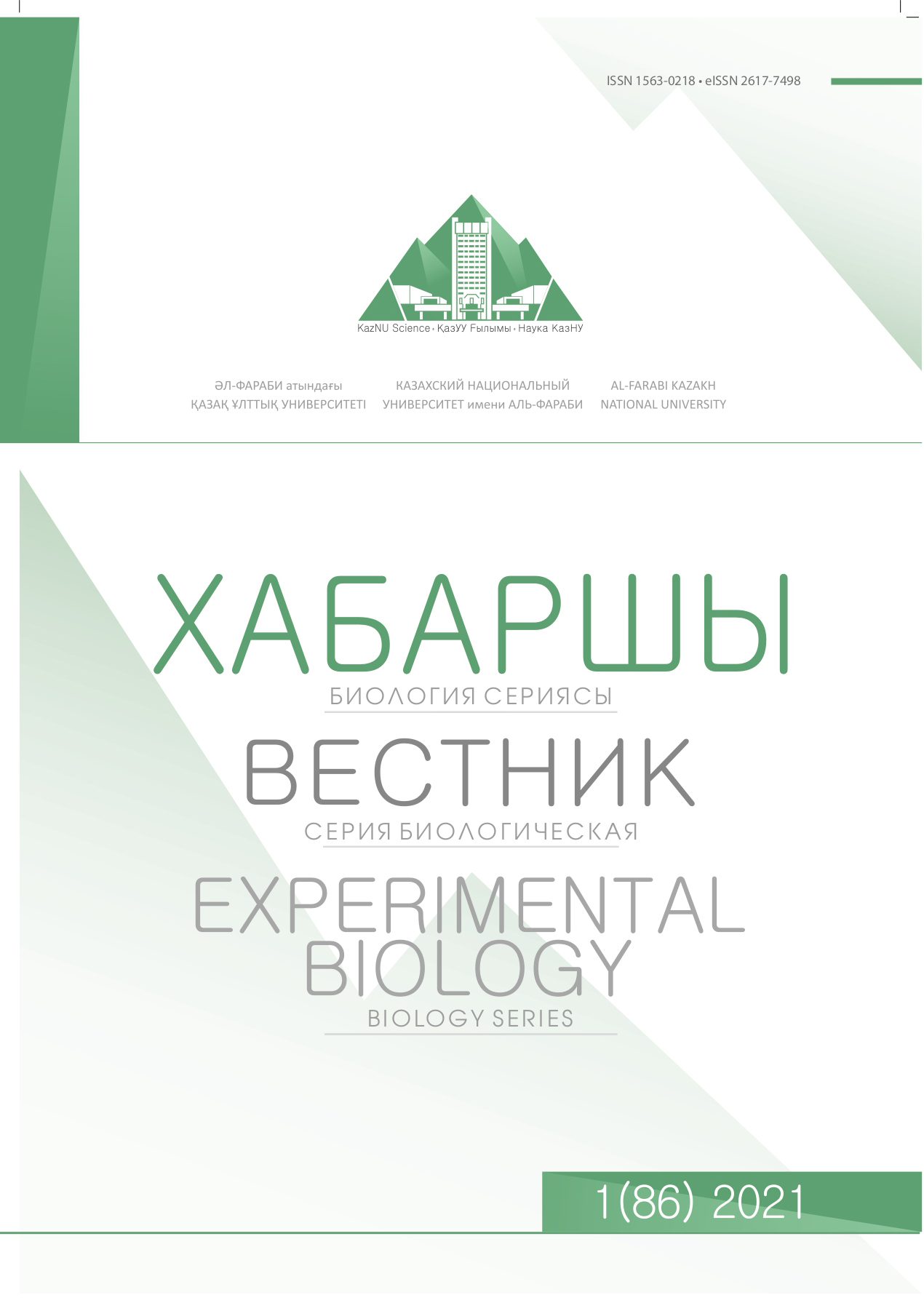DENSITY, NUMBER, AND AGE SPECTRUM OF THE RARE, ENDEMIC, MEDICINAL SPECIES ADONIS TIANSCHANICA LIPCH (ADOLF).
DOI:
https://doi.org/10.26577/eb.2021.v86.i1.04Abstract
The article describes the density, number and age spectrum of the rare endemic medicinal species Adonis tianschanica Lipch (Adolf). 3 populations of the species were studied. The first population was taken from the Kegen Pass, and 2 cenopulations of the species were found. The second population was found in the Tekeli gorge of Dzungarian Alatau and 2 cenopopulations of the same species as in 1 population were studied accordingly. The third population is between the villages of Saryjaz and Kainar, Terskey Alatau. A total of 3 populations and 5 coenopopulations were found and studied.
Given the global nature of the problem of biological diversity, the protection of not only individual species, but also a number of unique plant communities, their diversity and stability are important conditions for optimal environment. A small part of associations is to some extent aggravated in nature reserves or protected areas, but there is no general reference list of endangered and rare plant communities and their protection is very important for the future.
For all coenopopulations, accounting areas of 1m2 were built, the number of species and age composition were calculated according to the method of A. A. Uranov. In addition, the average density of individuals of the Adonis tianschanica Lipch (Adolf). type was calculated. A map has been constructed for the regions where three populations of the species are located (in Almaty region conditions). The space image was also used depending on the meeting point of coenopopulations (by geographical coordinates).
Graphs are compiled for the age composition of coenopopulations of the Adonis tianschanica Lipch (Adolf) type, and the current state of abundance, density, and age composition is estimated for 3 populations of the species.
Key words: Adonis tianschanica Lipch (Adolf), endem, coenopopulation, age composition, Dzungarian Alatau, Terskey Alatau.References
2 Zlobin YU.A., Sklyar V.G., Klimenko A.A. Populyatsii redkikh vidov rasteniy: teoreticheskiye osnovy i metodika
izucheniya. – Sumy: Universitetskaya kniga, 2013. P– 439.
3 Materialy seminara po proyektu: Planirovaniye sokhraneniya biologicheskogo raznoobraziya na natsional’nom urovne dlya podderzhaniya realizatsii Strategicheskogo plana Konventsii o biologicheskom raznoobrazii v Respublike Kazakhstan na 2010-2011 gg. Proyekt PROON po Natsional’noy Strategii biologicheskogo raznoobraziya i po bazam dannykh. – Almaty, dekabr’ 2012.
4 Hilton-Taylor C. 2000. IUCN Red List of Threatened Species, IUCN/SSC, Gland and Cambridge. (compiler)
5 Global strategy for plant conservation. Kew. – 2002. P- 62
6 Akeroyd J. A rational look at extinction // Plant Talk. – 2002. – Vol. 28. –P. 35-37
7 Flora Kazakhstana. – Alma-Ata, 1956. –T-9.
8 Negrobov O.P. Problemy regional’noy strategii sokhraneniya bioraznoobraziya // Vestnik VGU. Seriya khimiya, biologiya.
– 2000. P. 112-117.
9 Bramwell D. How many plant species are there? // Plant Talk. -2002. – Vol. 28. –P. 32-34.
10 Natsional’naya strategiya i Plan deystviy po sokhraneniyu i sbalansirovannomu ispol’zovaniyu biologicheskogo raznoobraziya RK. – Kokshetau, 1999.
11 Rands M.R., Adams W.M., Bennun L., Butchart S.H., Clements A., Coomes D., Entwistle A., Hodge I., Kapos V., Scharlemann J.P., Sutherland W.J., Vira, B. (2010) Biodiversity conservation beyond 2010. Science 329, 1298-1303.
12 Raven P.H. Chase J.M., Pires J.C. Introduction to special issue on biodivery // American Journal of Botany. – 2011. – Vol. 98(3). – P. 330-335.
13 The Plant List (2013). Version 1.1. Published on the Internet; http://www.theplantlist.org/tpl1.1/record/kew-2623204 (data supplied on 2012-03-23).
14 International Plant Names Index (IPNI). Royal Botanic Gardens Kew Science; https://www.ipni.org/n/708153-1
15 Rabotnov T.A. Zhiznennyy tsikl mnogoletnikh travyanistykh rasteniy v lugovykh tsenozakh. – Tr. Bot. Seriya 3, Geobotanika. Vyp. 6. M.-L. Izd-vo SSSR. 1950.
16 Toropova I.A. Spetsifika vzaimootnosheniy tsenopopulyatsiy vidov, otnositsya k odnomu fitotseiotipu. – V sb. “Struktura i dinamika rastitel’nogo pokrova”, M. “Nauka”. 1976.
17 Uranov A.A. Bol’shoy zhiznennyy tsikl i vozrastnoy spektr tsenopopulyatsiy tsvetkovykh rasteniy. – Tezisy dokl. U s”yezda VBO, Kiyev. 1973.
18 Rabotnov T.A. Fitotsenologiya. Izd-vo MU 1903.
19 B. Walker, Conservation Biology, 9(4) – 1995.
20 Uranov A.A. Vozrastnoy spektr tsenopopulyatsiy kak funktsiya vremeni i energeticheskikh volnovykh protsessov. Nauchn.
dokl. vyssh.shkoly. Biol.nauki, 1975, № 2.
21 Uranov A.A. Voprosy izucheniya struktury fitotsenoza i vidovykh tsenopopulyatsiy. V kn. «Tsenopopulyatsii rasteniy, Razvitiye i vzaimootnosheniya». M. «Nauka». 1977.
22 Kiyak V. G. Small plant populations: problems and prospects of research / V. G. Kiyak / / Botany and Mycology: problems and prospects for 2011-2020.- 2011, P- 18-20.
23 Smirnova O. V. Chislennost’ i vozrastnoy sostav populyatsiy nekotorykh komponentov travyanogo pokrova. – V kn. «Voprosy morfogeneza tsvetkovykh rasteniy i stroyeniya ikh populyatsiy», M. «Nauka». 1969.
24 Smirnova O.V. Ob”yem schetnoy yedinitsy pri izuchenii tsenopopulyatsiy rasteniy razlichnykh biomorf. – V kn. “Tsenopopulyatsii rasteniy (osnovnyye ponyatiya i struktura)”. M. “Nauka”. 1976.
25 Rabotnov T.A. Metody izucheniya semennogo razmnozheniya travyanistykh rasteniy v soobshchestvakh. – kn. “Polevaya geobotanika”, vyp,II, M.-L. Izd-vo SSSR, 1960.












